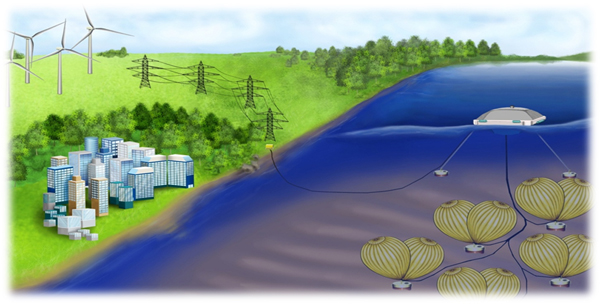Hydrostor is a new Toronto-based company with a novel concept for how to store energy. It uses off-peak power from the grid to compress air, via an advanced adiabatic compression system, into a series of flexible accumulators – air bags – located 50 to 500 meters below the surface of a sufficiently deep body of water. In the present case, Lake Ontario, with deep water right next to downtown Toronto, serves perfectly. Once in the accumulators, the energy can be stored until required by the grid. When the energy is required, the weight of the water pushes the air back to the surface where the system directs it through an expander, driving a generator and resupplying energy to the grid and completing the storage cycle. The company claims an overall, round-trip efficiency of 70%, without the need for additional fossil fuel heat.
 The company is working with Toronto Hydro on a trial installation, with generation capacity of 1 MW and four hours of storage. Toronto Hydro is providing a site, with the preferred location on one of the harbour islands, which has a transformer station and a cable to mainland with spare connection capacity. Toronto Hydro is also providing in-kind engineering, project management, the interconnection, dispatch and operation.
The company is working with Toronto Hydro on a trial installation, with generation capacity of 1 MW and four hours of storage. Toronto Hydro is providing a site, with the preferred location on one of the harbour islands, which has a transformer station and a cable to mainland with spare connection capacity. Toronto Hydro is also providing in-kind engineering, project management, the interconnection, dispatch and operation.
Hydrostor’s technology has some ideal qualities for locating close to city core: no emissions, no noise, fast to permit and implement. It’s easy to add to, with the main cost being the compressor-expander, while additional storage can be added quickly and cheaply, much more so than with new generation. It’s good for load balancing, price arbitrage and increased reliability. In the present case it will be used mostly to support a downtown “hot spot” constrained area. Currently it’s somewhere between a pilot project and early commercial, the company says. Once it proves itself, it can be scaled up to 2-4 MW capacity and 8 hours storage.
Energy storage is new technology and a bit of an orphan child, when it comes to recognizing its value as an ancillary service. “There are definite system benefits with energy storage (i.e. load balance, price arbitrage, emergency response, voltage stability, spinning reserve, deferred infrastructure, etc.) but the regulator hasn‘t come to terms with it yet,” said Jack Simpson, Director of Capacity Planning at Toronto Hydro.
Tom Rand, who works at the MaRS Centre in Toronto assisting startup companies getting to market, agrees: “Right now we have a regulatory environment that is very difficult for storage. But these guys have built a fairly sophisticated understanding of how to cobble together arbitrage, cap-ex deferment for Toronto Hydro, and so on, to come up with a merchant plant model to get funded. That is a very interesting, paradigmatic case of how energy systems are going to be at the forefront of a low-carbon grid. Then, presumably the OEB, the IESO and the OPA will coordinate the regulatory environment to get storage in the rate base. This will blow batteries out of the water, producing power at half or a third the price of battery storage. And the potential is very large, with 50% of the world’s population living next to water.”
Sandia National Laboratories in the United States has a report that identifies some 26 different ways that storage can benefit the grid, but ways are still needed to value the benefit for all the actors. “For example, under the FIT, a wind farm gets paid for every kWh it produces, so it has no reason to include storage. But the time is coming when it will be included in the rate base. Storage is the killer app in energy,” says Tom Rand.
